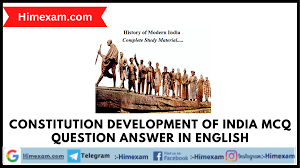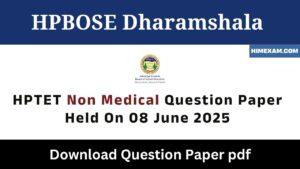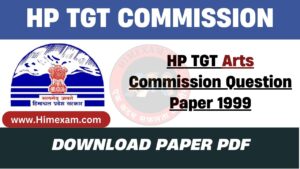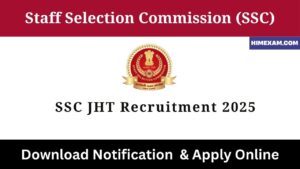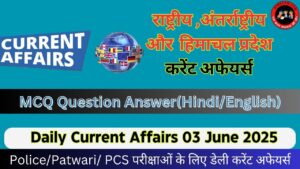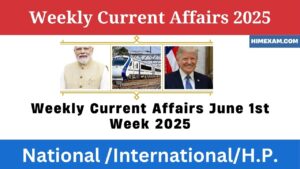||The Constitutional Development of India MCQ in English||The Constitutional Development of India Question Answer in English||
1.In which of the following Acts, the provision was made for the establishment of Supreme Court at Calcutta?
(A) Regulating Act, 1773
(B) Pitt’s India Act, 1784
(C) Charter Act, 1813
(D) Charter Act, 1833
2. By which one of the following Acts was the Federal Court in India created?
(A) Indian Council Act, 1861
(B) Government of India Act, 1909
(C) Government of India Act, 1919
(D) Government of India Act, 1935
3. Which Act of British Parliament abolished the East India Company monopoly over trade in India?
(A) Regulating Act
(B) Pitt’s India Act
(C) Charter Act of 1813
(D) None of the above
4. By which of the following Act, Legislative Council of India received the power to discuss the budget?
(A) Indian Council Act, 1861
(B) Indian Council Act, 1892
(C) Indian Council Act, 1909
(D) Indian Council Act, 1919
5. The Federal Court of India was established in which of the following year?
(A) 1935
(B) 1937
(C) 1946
(D) 1947
6. In the context of Indian history, the principle of ‘Dyarchy (diarchy)’ refers to
(A)Division of the central legislature into two houses
(B) Indtroduction of double government i.e., Central and State Governments
(C) Having two sets of rulers; one in London and another in Delhi
(D) Division of the subjects delegated to the provinces into two categories
7. Under which of the following Acts, Dyarchy was introduced at Central level?
(A) Act of 1909
(B) Government of India Act, 1919
(C) Government of India Act, 1935
(D) Indian Independence Act, 1947
8. Which of the following Acts set up Dyarchy System at the central level?
(A)Government of India Act, 1935
(B) Government of India Act, 1919
(C) Indian Councils Act, 1909
(D) Indian Councils Act, 1892
9. The Act of 1909 was associated with
(A) Introduction of separate electorate
(B) Decentralization
(C) Dyarchy
(D) Legislative Councils
10. Which of the following Acts introduced the ‘Principle of Constitutional Autocracy’?
(A) The Indian Councils Act of 1909
(B) The Government of India Act of 1919
(C) The Government of India Act of 1935
(D) The Indian Independence Act of 1947
11. The Indian Legislature was made bi-cameral for the first time by
(A) Indian Council Act of 1892
(B) Indian Council Act of 1909
(C) The Government of India Act of 1919
(D) The Government of India Act of 1935
12. Which of the following Acts introduced a bi-cameral legislature at the Centre?
(A) 1961 Act
(B) 1917 Act
(C) 1919 Act
(D) 1915 Act
13. The power of the President to issue ordinance is a relic of
(A) G.O.I. Act, 1919
(B) G.O.I. Act, 1935
(C) G.O.I. Act, 1909
(D) Indian Independence Act, 1947
14. Which Act for the first time made it possible for Indians to take some share in the administration of their country?
(A) Charter Act, 1833
(B) Charter Act, 1853
(C) Government of India Act, 1858
(D) Indian Councils Act, 1861
15. The distribution of power between Centre and States as in the Constitution of India is based on which of the following plans?
(A) Morely-Minto Reform, 1909
(B) Montagu-Chelmsford Reform, 1919
(C) Government of India Act, 1935
(D) Indian Independence Act, 1947
16. A ‘Federal System’ and ‘diarchy’ at the ‘Centre’ was introduced in India by UPPCS
(A)The Act of 1909
(B) The Act of 1919
(C) The Act of 1935
(D) None of the above
17. The provision for the establishment of All India Federation was included in the
(A)Government of India Act, 1935
(B) August Offer, 1940
(C) Government of India Act, 1919
(D) Cabinet Mission Proposal, 1946
18. Which one of the following Acts provided for a federal polity in India?
(A) Government of India Act, 1909
(B) Government of India Act, 1919
(C) Government of India Act, 1935
(D) India Independence Act, 1947
19. In the Federation established under the Act of 1935, residuary powers were given to the
(A) Federal Legislature
(B) Provincial Legislature
(C) Governor-General
(D) Provincial Governor
20. Which one of the following is not an important and permanent constituent in the Constitutional History of India as adopted in the Government of India Act, 1935?
(A) A written Constitution for the country
(B) Elected representation responsible to the Legislature
(C) Envisaging a scheme of Federation
(D) Nomination of official members to the Legislature
21. One amongst the following was not a salient feature of the Government of India Act, 1935.
(A) The Act provided for an All India Federation
(B) Residuary subjects were allocated to provincial Legislatures
(C) It marked the beginning of the Provincial Autonomy
(D) It abolished Diarchy at the Provincial level and introduced it at the Centre
22. Why is the Government of India Act, 1935 important?
(A) It is the main source of the Constitution of India
(B) It gave Independence to India
(C) It envisages partition of India
(D) It abolished the Native States
23. Which one of the following Acts led to the separation of Burma from India?
(A) The Indian Councils Act, 1909
(B) Government of India Act, 1919
(C) Government of India Act, 1935
(D) Indian Independence Act, 1947
24. The proposal for framing of the Constitution of India by an elected Constituent Assembly was made by
(A) Simon Commission
(B) Government of India Act, 1935
(C) Cripps Mission
(D) British Cabinet Delegation
25. The objective of Ilbert Bill in reference to colonial rule in India was
(A) To bring Indians and Europeans at equal status as far as the penal jurisdiction of courts was concerned
(B) To put a strict restriction on local press because they were considered anti to colonial rulers
(C) To conduct Administrative Service Exams in India to encourage Indians to participate in it
(D) To amend the Arms Act for weapon permit to Indians
26. As per Cabinet Mission plan, in the constituent assembly to decide alloted members seat in each province, one representative was in ratio to which population?
(A) 8 lakh
(B) 10 lakh
(C) 12 lakh
(D) 15 lakh
27. Who among the following persons was not a member of the Cabinet Mission?
(A) William Wood
(B) Pethick Lawrence
(C) Stafford Cripps
(D) A.B. Alexander
28. Indian Constituent Assembly was established under
(A)Government of India Act, 1935
(B) Cripps Mission, 1942
(C) Cabinet Mission, 1946
(D) Indian Independence Act, 1947
29. In the Interim Government formed in 1946, the Vice-President of the Executive Council was
(A) Jawaharlal Nehru
(B) Dr. S. Radhakrishnan
(C) C. Rajagopalachari
(D) Dr. Rajendra Prasad
30. Who of the following was not the member of the Interim National Government formed in August 1946 A.D.?
(A) C. Rajagopalachari
(B) Dr. Rajendra Prasad
(C) Dr. S. Radhakrishnan
(D) Jagjiwan Ram
31. Who gave the idea of a Constituent Assembly firstly for the formation of Constitution for India?
(A) Swaraj Party in 1934
(B) Congress Party in 1936
(C) Muslim League in 1942
(D) All Parties conference in 1946
32. Which one among the following is an incorrect statement about the Constituent Assembly?
(A) It worked with the help of a large number of committees, the most important among them being the Drafting Committee
(B) Minority communities like Christians, Anglo-Indians and Parsis were adequately represented in the Assembly
(C) It was elected on the basis of universal adult franchise
(D) Its electoral process was based on the sixth schedule of the Act of 1935 which allowed for a restricted franchise based on tax, property and educational qualification
33. Member of constituent assembly, who drafted the Constitution of India, were
(A) Nominated by British Parliament
(B) Nominated by GovernorGeneral
(C) Elected by legislative assemblies of various provinces
(D) Elected by Indian National Congress and Muslim League
34. With reference to Indian History, the Members of the Constituent Assembly from the Provinces were
(A)Directly elected by the people of those Provinces
(B) Nominated by the Indian National Congress and the Muslim League
(C) Elected by the Provincial Legislative Assemblies
(D) Selected by the government for their expertise in constitutional matters 310 Objective General Studies
35. How were the members of Constituent Assembly elected?
(A) Directly by public
(B) Nominated by Congress
(C) Nominated by Indian ruler
(D) By Provincial assemblies
36. Who was the first elected Chairman of Constituent Assembly?
(a) Dr. B.R. Ambedkar
(B) Dr. Sachchidanand Sinha
(C) Dr. Rajendra Prasad
(D) Dr. S. Radhakrishnan
37. Who chaired the first meeting of Constituent Assembly?
(A) Dr. Rajendra Prasad
(B) Dr. Bhimrao Ambedkar
(C) Dr. Sachchidanand Sinha
(D) Maulana Abul Kalam Azad
38. Who was the President of the Constituent Assembly of Independent India?
(A) Dr. Bhimrao Ambedkar
(B) Dr. Rajendra Prasad
(C) C. Rajagopalachari
(D) K. M. Munshi
39. Constituent Assembly of India was established on
(A) 10 June, 1946
(B) 9 December, 1946
(C) 26 November, 1949
(D) 26 December, 1949
40. The resolution for giving a Constitution to India was adopted by the Constituent Assembly on
(A) 22 January, 1946
(B) 22 January, 1947
(C) 20 February, 1947
(D) 26 July, 1946
41;Who proposed the Preamble before the Drafting Committee of the Constitution?
(a)Jawaharlal Nehru
(B) B.R. Ambedkar
(C) B.N. Rao
(D) Mahatma Gandhi
42. Who of the following presented the objectives resolution?
(A) Dr. B.R. Ambedkar
(B) Pt. Jawaharlal Nehru
(C) Dr. Rajendra Prasad
(D) Dr. C.D. Deshmukh
43. How many Sessions of the Indian Constituent Assembly were conducted for the formulation of Indian Constitution?
(A) 7
(B) 9
(C) 12
(D) 15
44. How much time the Constituent Assembly took to frame the Constitution of India?
(a) 2 years, 11 months, 18 days
(B) 2 years, 7 months, 23 days
(C) 3 years, 4 months, 14 days
(D) 3 years, 11 months, 5 days
45. Who among the following was the chairman of the Union Constitution Committee of the Constituent Assembly?
(A) B.R. Ambedkar
(B) J.B. Kripalani
(C) Jawaharlal Nehru
(D) Alladi Krishnaswami Iyer
46. Who was the Chairman of the Provincial Constitution Committee of the Constituent Assembly?
(a) Dr. B.R. Ambedkar
(B) Pt. Jawaharlal Nehru
(C) Dr. Rajendra Prasad
(D) Sardar Patel
47. Who was the Chairman of the Drafting Committee of the Indian Constitution?
(A) Dr. Bhimrao Ambedkar
(B) Dr. Rajendra Prasad
(C) Sachchidanand Sinha
(D) C. Rajagopalachari
48. Who was the Chairman of Advisory Committee on Fundamental Rights and Minorities constituted by the Constituent Assembly?
(A) Pandit Nehru
(B) Sardar Patel
(C) B.N. Rao
(D) Ambedkar
49. The Drafting Committee of the Constituent Assembly under Dr. B. R. Ambedkar had how many other members?
(A) 7
(B) 6
(C) 5
(D) 4
50. Who amongst the following was not a member of the Drafting Committee of the Constitution?
(A) Mohammad Sadullah
(B) K.M. Munshi
(C) A.K. Iyer
(D) Jawaharlal Nehru
51. The Constituent Assembly set up a Drafting Committee under the Chairmanship of Dr. B.R. Ambedkar on
(A) 13th December, 1946
(B) 22nd January, 1947
(C) 3rd June, 1947
(D) 29th August, 1947
52. Who was the Constitutional Advisor at the time of the formation of the Constitution?
(A) Dr. B.R. Ambedkar
(B) Dr. Rajendra Prasad
(C) B.N. Rao
(D) K.M. Munshi
53. The first draft of the Constitution was prepared by
(A) B.R. Ambedkar
(B) B.N. Rao
(C) K. Santhanam
(D) K.M. Munshi
54. When did the Constituent Assembly adopted the National Flag?
(A) 22 July, 1947
(B) 23 July, 1947
(C) 25 July, 1947
(D) 15 August, 1947
55. Who was the Chairman of the National Flag Committee?
(A) C. Rajagopalachari
(B) Dr. Rajendra Prasad
(C) J.B. Kripalani
(D) Dr. B.R. Ambedkar
56. When was the third reading of the Indian Constituent Assembly started?
(A) 17th November, 1949
(B) 14th November, 1948
(C) 25th November, 1948
(D) 25th November, 1949
57. The Constitution of India was completed on
(A) January 26, 1950
(B) November 26, 1949
(C) February 11, 1948
(D) None of the above is correct
58. Indian Constitution was adopted by the Constituent Assembly on
(A) 26 November, 1949
(B) 15 August, 1949
(C) 2 October, 1949
(D) 15 November, 1949 I
59. Constitution of India came in force on
(a)26 January, 1950
(B) 23 January, 1950
(C) 15 August, 1947
(D) 26 December, 1949
60. January 26 was selected as the date for the inauguration of the Constitution, because
(A) The Congress had observed it as the Independence Day in 1930
(B) On that day the Quit India Movement was started in 1942
(C) It was considered to be an auspicious day
(D) None of the above
61. Indian Constitution was adopted by
(A) Constituent Assembly
(B) British Parliament
(C) Governor-General
(D) Indian Parliament
62. The Constitution of India was enacted on 26 November, 1949 by the
(a)Constituent Assembly
(B) Governor-General of India
(C) Parliament of India
(D) British Parliament
63. Constitution Day of India is celebrated on
(A) 26th October
(B) 26th November
(C) 26th January
(D) 15th August
64. B.R. Ambedkar was elected to the Constituent Assembly from
(A)West Bengal
(B) Bombay Presidency
(C) Middle India
(D) Punjab
65. Year of birth and death of Dr. B.R. Ambedkar.
(A)1886, 1951
(B) 1891, 1956
(C) 1877, 1961
(D) 1889, 1961
66. In which year was ‘Jana Gana Mana’ adopted as the National Anthem of India?
(A) 1948
(B) 1949
(C) 1950
(D) 1951
67. The state emblem was adopted by Govt. of India on
(A) 15th August, 1948
(B) 2nd October, 1947
(C) 26th January, 1948
(D) 26th January, 1950
68. Deferment of Adult Franchise for fifteen years was advocated in Constituent Assembly by
(A) Dr. Rajendra Prasad
(B) Jawaharlal Nehru
(C) Maulana Azad
(D) Dr. Bhim Rao Ambedkar
69. Who amongst the following advised that the Indian National Congress should be disbanded as a political party after the independence of India?
(A)C. Rajagopalachari
(B) Jai Prakash Narayan’
(C) Acharya Kripalani
(D) Mahatma Gandhi
70. “In their nationalist reaction, the Founding Fathers of Indian Constitution tended to minimize the importance of minority interests and emotions”. This view is credited to
(A) Morris Jones
(B) Hardgrave Junior
(C) Alexandrovitz
(D) Ivor Jennings
71. “Constituent Assembly was Congress and Congress was India”, who said this?
(A) Austin
(B) C.R. Attlee
(C) Winston Churchill
(D) Lord Mountbatten
72. How many women members were there in the Indian Constituent Assembly?
(A) 15
(B) 13
(C) 12
(D) 10
73. The States and the Central Government derive power from
(A) The Constitution of India
(B) The President of India
(C) The Prime Minister of India
(D) The Parliament of India
74. In how many provinces was the Congress Ministry formed in the election of the year 1937?
(A) 11
(B) 9
(C) 8
(D) 3
75. Which of the following is/are the principal feature(s) of the Government of India Act, 1919?
1. The introduction of dyarchy in the executive Government of the provinces.
2. The introduction of separate communal electorates for Muslims.
3. Devolution of legislative authority by the centre to the provinces. Select the correct answer using the codes given below.
(A) Only 1
(B) Only 2 and 3
(C) Only 1 and 3
(D) 1, 2 and 3
76. Which of the following statements is/are not true in relation to Constituent Assembly?
1. Assembly was not based on adult suffrage.
2. The assembly was a result of direct election.
3. Assembly was a multiparty body.
4. Assembly worked through various committees.
Choose the correct answer by using the code given below.
Code
(A) 1 and 2
(B) 2 and 3
(C) 1 and 4
(D) 1, 2, 3 and 4
77. In relation to formation of the Constitution of India, which of the following sentences is/are correct?
1. Resolution of objectives by Nehru affected the making of the Constitution.
2. Preamble fulfills various important objectives/aims.
3. Peoples of India ordered/ directed the Constitution.
4. Head of the state is elected by the people directly.
Code
(A) 1, 2 and 3
(B) 1, 3 and 4
(C) 2, 3 and 4
(D) All of these
78. Who among the following were the members of the drafting committee of the Constitution?
1. N. Gopalaswami
2. Jawaharlal Nehru
3. Alladi Krishnaswami Iyer
4. Sardar Patel Select the correct answer using the codes given below.
(A)1, 3 and 4
(B) 1 and 4
(C) 1 and 3
(D) 2, 3 and 4
79. Consider the following statements.
1. The design of the National Flag was adopted by the Constituent Assembly of India on 22nd July, 1947.
2. The wheel in National Flag has 21 spokes.
3. The ratio of the width of the National Flag to its length is 3 : 4. Which of the above statements is/ are correct?
(A) 1 and 2
(B) Only 1
(C) 2 and 3
(D) Only 2
80. Consider the following statements.
1. The discussions in the Third Round Table Conference eventually led to the passing of the Government of India Act, 1935.
2. The Government of India Act, 1935 provided for the establishment of an All India Federation to be based on a Union of the Provinces of British India and the Princely States. Which of the statement(s) given above is/are correct?
(A) Only 1
(B) Only 2
(C) Both 1 and 2
(D) Neither 1 nor 2
81. Match List-I with List-II and select the correct answer using the code given below the lists.
List-I
(a) Establishment of Board of Control
(b) Establishment of Supreme Court
(c) Permission to English Missionaries to work in India
(d) Appointment of Law Member in Governor-General Council
List-II
1. Regulating Act, 1773
2. Pitt’s India Act, 1784
3. Charter Act, 1813
4. Charter Act, 1833
Code (a) (b) (c) (d)
(A) 1 2 3 4
(B) 2 1 3 4
(C) 1 2 4 3
(D) 2 4 1 3
82. Assertion (A): According to the Wavell Plan, the number of Hindu and Muslim members in the Executive Council was to be equal.
Reason (R): Wavell thought that this arrangement would have avoided the partition of India.
Code
(A) Both (A) and (R) are true and (R) is the correct explanation of (A)
(B) Both (A) and (R) are true, but (R) is not the correct explanation of (A)
(C) (A) is true, but (R) is false
(D) (A) is false, but (R) is true
83. Match List-X with List-Y and select the correct answer using the code given below the lists.
List-X
(a) First Vice-President of Constituent Assembly
(b) Originally the only Congress Member of Drafting Committee
(c) Member of Constituent Assembly representing Rajasthan’s Princely State
(d) Chairman of Union Constitution Committee
List-Y
1. V.T. Krishnamachari
2. Jawaharlal Nehru
3. K.M. Munshi
4. H.C. Mukherjee
Code (a) (b) (c) (d)
(A) 1 4 2 3
(B) 4 3 1 2
(C) 1 2 3 4
(D) 3 4 1 2
84. Here are two statements.
Assertion (A): The Constitution of India provides for all necessities of the country.
Reason (R): It is known or called as ‘Adopted’ Constitution. In relation to aforesaid which one is true?
(A) Both (A) and (R) are true and (R) is the correct explanation of (A)
(B) Both (A) and (R) are true, but (R) is not the correct explanation of (A)
(C) (A) is true, but (R) is false
(D) (A) is false, but (R) is true
85. Consider the following statements and choose the correct answer by using the codes given below.
Assertion (A): India is a democratic country.
Reason (R): India has a constitution of its own.
Code (A) Both (A) and (R) are true and (R) is the correct explanation of (A)
(B) Both (A) and (R) are true, but (R) is not the correct explanation of (A)
(C) (A) is true, but (R) is false
(D) (A) is false, but (R) is true
हेलो दोस्तों ,आपका हमारी वेबसाइट Himexam.com पर स्वागत है। जैसा की आपको पता है हमारी वेबसाइट Himexam.com आपको समय-समय पर सभी HP Govt Jobs & All India Govt Jobs की Notifications प्रदान करवाती है। साथ ही साथ Himachal Pradesh Exam Previous Paper और Himachal Pradesh GK ,Himachal Pradesh & National +International Current Affairs के सभी नोट्स मुफ्त उपलब्ध करवाते है। हमारी वेबसाइट के अलग अलग प्लेटफार्म पर pages & Group बने है जैसे की facebook ,Telegram और Instagram .. अगर आप हिमाचल के किसी भी पेपर की तैयारी कर रहे हो तो जल्दी से इन groups के साथ जुड़ जाएं इनके लिंक नीचे table में दिए गए है।

